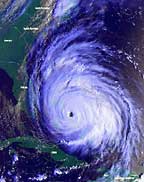Exploring and investigating ocean habitats and resources
Overview
The earth is the only known living planet, and its life is derived largely from its oceans. Over a hundred years of oceanographic research shows that the oceans play a critical role in regulating weather and climate, host extraordinarily diverse life forms, and provide significant biological and mineral resources. It is NOAA's responsibility to manage U.S. territorial waters to insure environmental and ecosystem health, economic stability and growth, and human health and safety. NOAA Research scientists work with managers in all these areas to provide the information needed to accomplish these objectives.
NOAA's research laboratories, National Sea Grant College Program, National Undersea Research Program, and research partners study a very wide range of topics related to the oceans and U.S. Great Lakes. These include coastal hazards, ocean circulation, pollution, invasive species, fisheries and aquaculture, and ocean products. In all, the ultimate objective is to improve or at least maintain ecosystem health while improving human quality of life.
NOAA Research is working towards accurate prediction of the effects of natural and man-made environmental change in order to eliminate or reduce them.
Key Issues for the United States
A variety of hazards regularly threaten the nation's coastal inhabitants. Severe meteorological events such as hurricanes, tropical cyclones and northeasters often bring high winds, storm surges, flooding and shoreline erosion that are particularly damaging to coastal areas.
Although natural hazards have occurred throughout history, their recent impacts have been increasingly devastating. Estimated disaster losses in the United States range from $10 billion to $50 billion annually, with an average cost from a single major disaster around $500 million. One of the primary factors contributing to the rise in disaster losses is the steady increase in the population of high-risk areas, such as coastal areas.
In addition to the threats to the U.S. coastline, the general welfare of the Nation's living marine resources is at risk. The decline in Northeast groundfish, the precarious state of some West Coast salmon runs, and the reduced populations of sharks and other marine species are just a few of the areas that require special attention.
Although many of our living resources remain healthy, the pressures and demands placed on them will continue to increase. The challenge is to maintain the long-term viability of the natural system, while at the same time addressing the social and economic needs of the fisheries. For example, NOAA recognizes that a stronger U.S. aquaculture industry can significantly increase domestic fisheries supplies, and work to hold in check or decrease the U.S. seafood deficit, which reached nearly $7 billion in 1998.
Impacts on Public Safety
Oceanic processes and events can have significant consequences for public safety, although the scales of the events are quite different. NOAA predicts tsunamis, floods, coastal erosion, significant sea level changes and storm surges. In addition, NOAA weather and oceanographic information has specific consequences and application to boating and marine safety (including marine accidents). In all of these, NOAA Research provides the means to improve predictions and reduce the human effects of natural events.
Impacts on the Economy
American aquatic living resources are sources not only of food, but also for recreation and improved quality of life. NOAA Research acts to reduce overfishing by helping improve population estimates, studying the causes and consequences of habitat destruction (hypoxia, anoxia, wetlands destruction, damage by fishing gear), and by promoting and developing aquaculture to replace lost natural populations and satisfy demand without damaging wild stocks. It also helps maintain natural biodiversity and minimize invasive species and their effects. Through studies of extremophiles, NOAA Research also plays a crucial role in the development of industrial biotechnology and ocean engineering. Finally, through educational and informational programs, NOAA research promotes responsible use of aquatic resources, growth of coastal economies, and an informed citizenry.
Impacts On Public Health
Effects of water quality on environmental health and its consequences to public health can be significant, and on occasion, life threatening. Increased nutrients from human activities can result in extraordinary abundances of a wide variety of harmful algal blooms, red tides, and other microorganisms such as Pfiesteria. Blooms of some aquatic organisms can produce toxins virulent enough to kill humans who eat organisms in which the toxins are concentrated, such as mussels and oysters. Non-nutrient chemical pollution and its effects is also a serious problem for all living organisms exposed to the polluted waters. NOAA Research works closely with other federal, state, and local agencies to determine the sources, amounts, and effects of these contaminants.
What NOAA Research Can Do
- Provide information leading to restoring depleted populations of exploited and protected species;
- Reduce coastal hazards from contaminated water, harmful algal blooms, coastal erosion, and marine accidents;
- Develop and promote sustainable marine aquaculture;
- Provide integrated scientific information to support informed decisions regarding land use, water resource management, fisheries management, and ecosystem health;
- Better characterize and understand the role of the oceans in weather and climate predictions;
- Develop and provide essential understanding of the physical, chemical, and biological aspects of the oceans and Great Lakes in support of comprehensive ecosystem management;
- Foster public ability to understand and ind integrate scientific information in finding solutions to environmental issues; and
- Increase long-term commitment to research by recruiting the best scientists, increasing funding, streamlining processes, and modernizing systems.


